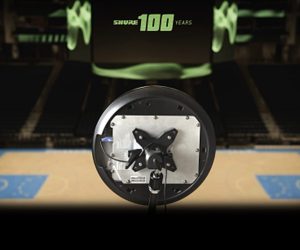
Great Expectations
University of Newcastle’s Great Hall gets a great big AV makeover.
Photos:/ Jason Smith Photography
UON had high hopes of shifting the AV of its ’70s-built Great Hall into a totally new gear. In its brief to AV consultant, Indesign Technologies, the technology makeover would significantly improve the Great Hall’s audio and video quality and reliability. The old analogue system would convert to a full digital AV-over-IP solution. The result would be a vastly more flexible and scalable system that reflects the diverse requirements of the venue. We take a tour of some of the project highlights.

HOSTILE ACOUSTICS: FRIENDLY AUDIO
The space is awkward: 30m from front to back with a stepped ceiling; some ceilings are 20m high ceilings; lots of concrete, brick and timber surfaces. Detailed EASE diagrams were produced to optimise the speaker placement — Martin Audio WPM ultra-compact line array, passive two-way (2 x 6.5-inch/3 x 1.4-inch), 16Ω enclosures. Martin MSX subs are hung behind the main WPM arrays.

TRANSPARENT LED
This technology has every second row of LEDs missing on a 10mm deep transparent PCB – providing a translucent screen look that’s far less obtrusive than a jet black or stark white screen when not in operation. Thanks to the small pixel pitch it provides an excellent quality image as well. The Novastar screen is bright, operating at only a third of its potential output.

NETWORK EVERYWHERE: AV OVER IP
UON is a Crestron uni and has relied on Crestron DM as its HDBaseT transportation system. This install uses the brand new, and largely untested, Crestron NVX video-over-IP transportation platform — one of the first roll outs in Australia. All the audio sat on the network via Dante, including hearing augmentation, DSP, wireless microphones etc – about 120 inputs and outputs. The result saw every single device run on the network (with Cisco switches). The only transport cable is shielded Cat6a, as witnessed here with the connection of a Panasonic IP PTZ camera.

STAND & DELIVER: LECTERN
The Lectern Hub unit features a Wolfvision document camera, Audio-Technica gooseneck mic, Crestron touchscreen control, an Extron recording and streaming processor, and a Mersive Solstice collaboration system.

GREAT HALL PA: MORE SOUND THINKING
The Great Hall’s audio upgrade was undoubtedly the biggest ticket item of the upgrade and also one of the curliest. Among the challenges were: the hostile acoustics, the super-tight delivery timeframe, the budget and the uncertainty of structural loading capabilities.
A Martin Audio PA was selected, which in itself has an interesting back story. Indesign Technologies Director Peter Coman: “In the first instance, the client had a previous Martin Audio installation they were very happy with, and secondly, we trust the brand. Martin Audio provides a value-for-money solution, was able to offer a system that was fit for purpose, and it met our budget.”
He continued: “On top of that, the entire system is digital, so being able to incorporate the Martin Audio Dante amplifiers (pictured) integrated perfectly into the rest of the system.”
Finally, there was the question of availability, since there was an extremely short timeframe to deliver the project. “Martin Audio assured us it could meet the deadlines,” said Coman, adding that it had the speakers specially manufactured and flown over in record time. “But the main driver was the support from TAG [Technical Audio Group]; they were always available to provide the technical expertise required to deliver this complex project, from design and commissioning with expert installation from Xcite AV.”

The FOH PA consists of 14 x Martin WPM per side with 4 x MSX subs flown per side, while the delay hangs comprise 10 x Martin WPM per side. Front fill consists of 6 x Martin CDD6 below the front lip of the stage and a pair of Martin CDD6 as out fills to cover the outside front corners.
The flown hang of four subs aside wasn’t the team’s first configuration choice. TAG’s Ewan McDonald explains: “The original plan was for a custom tapered column array that would attempt to match the throw of the main WPM arrays. As is the case with line arrays, the low frequencies fall off faster than the high frequencies so we needed to try and get a tall line of spaced subwoofers to combat this.” Unfortunately, the uni couldn’t see past the optics of the proposal and kiboshed the plan in favour of the smaller sub array we see today.
Amplifiers/FIR processing consists of 7 x iKON IK81 and 2 x IK42. Due to the challenging acoustic space, every WPM and MSX enclosure is individually powered and processed. Ewan McDonald again: “Martin Audio allows you to set ‘hard avoid’ areas where it will actively cancel energy to those surfaces. This was really important given the huge reflector of a back wall and the lectern position which could be directly under the arrays.” Once onsite, David Gilfillan (Gilfillan Soundwork) carefully examined the real world results using a combination of critical listening and measurements to ensure the right balance was met.















RESPONSES